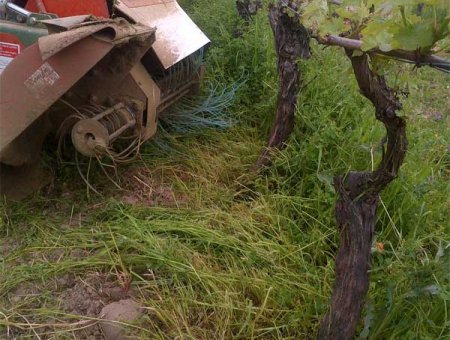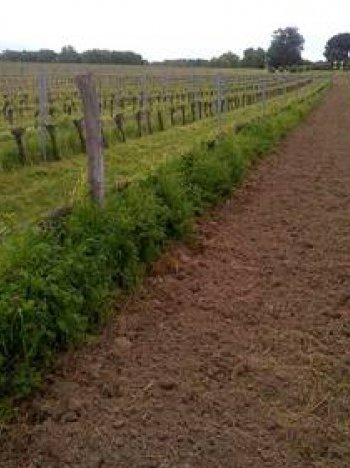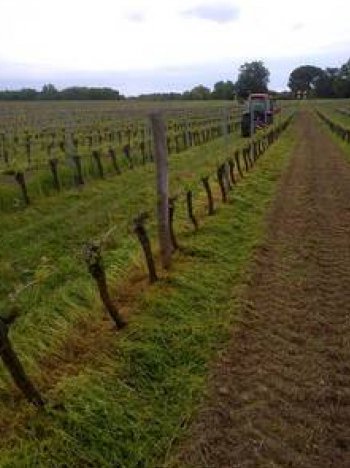In-row mower
In-row mowers are designed to control weed growth under the rows to limit inputs, and require low forward speeds. They come in three types: vertical-axis mowers with blades, vertical-axis string mowers and horizontal-axis string mowers. Models with blades leave a strip of grass around the vines to prevent injury, while those with wires can mow closer to the base of the vines. But the latter are less efficient and more prone to wear. Horizontal-shaft mowers are efficient and versatile, allowing mowing close to the stumps and combined operations, but they require sufficient trunk height and generate a lot of dust in dry terrain.

Work objective
In-row mowers have been developed to control weed growth under the rows, with a view to limiting inputs. This technique for maintaining the soil under the rows, like all the others, requires a low forward speed.There are several types of in-row mower:
- vertical shaft mowers with blades
- vertical-shaft string mowers
- horizontal-shaft string mowers
Vertical shaft blade mowers
Depending on the design of the tool, the approach to the stump is more or less precise, but as a general rule blade tools leave an unmown strip around the base.Using blades on satellites means leaving a strip of grass of around 25 mm around the stock, otherwise the blade risks injuring the stock, especially in the case of twisted vines. Some machines use a combination of blade and string on the same rotor to clean the stock perfectly, as the string finishes the job by reaching right up to the stock.
Ferrand equips its machines with a metal shell that rests on the ground, regulating the cutting height and limiting blade-to-soil contact.
The oil flow required is 20 to 30 l/min, depending on the cutting width, which can vary from 30 to 60 cm. Forward speed is variable (2 to 4 km/h).
Components of the in-row blade mower
The upper deck
The top deck is generally made of steel and has a wrap-around design to protect the feet.The hydraulic motor
The blade holder is driven by a hydraulic motor. The engine capacity depends on the cutting width of the mowing unit.The blade
Each mowing unit can be fitted with 2 or 4 blades. The blades can be freely or fixedly mounted.The deletion system
Depending on the design of the tool, the deletion system may be mechanical or hydraulically assisted. With mechanical assistance, the mowing satellite is mounted on a pivot. In this case, it is possible to clear the lawn by pressing down and bypassing. Some manufacturers, such as Naturagriff, have adapted intervine mowing heads to hydraulic clearing systems. Souslikoff has modified the gooseneck attachment on its Décalex Air (pneumatic assistance), making its mulching system versatile since it can be fitted with Aviff 33 intervine mowing heads.Ground tracking
Ground tracking can be mechanical (dome under the rotor, ground tracking wheel) or electro-hydraulic using a sensor.Adjustment and use of the in-row blade mower
Setting
In order to best adapt to different vineyards, manufacturers offer tools with different designs.On mowers fitted with a mechanical retraction system, it is possible to modify :
- The tension of the return spring, allowing the tool to return more or less quickly.
- Theorientation of the cutting head, to be able to work on plots with a heel of soil under the row.
- The precision of the work by modifying the sensitivity of the triggering system and by adjusting the distance between the detection antenna and the mowing satellite, it is possible to get closer or further away from the stock.
- Theinclination of the cutting head.
The cutting height is adjusted by means of skids or setting wheels when the tool is not combined, and by means of the fixing flange when it is combined with another tool.
Use
Intervine mowers can be used on plots where there is a lot of plant cover. Their design does not allow you to get as close as possible to the stalks. At AVIF 33, it is possible to replace the blade mowing head with a string mowing head and thus benefit from the advantages of both mowing systems.Vertical shaft string mower
Similar in design to the previous mowers, the main difference is the use of wire instead of steel blades. String mowers are more widely used in vineyards than blade mowers, but are less effective than blades. That's why users prefer to go for horizontal-axis inter-bine mowers, because their efficiency and versatility, along with their ability to remove shoots, make them more attractive.
Horizontal axis string mower
The risk of injury is limited because wires are generally less aggressive than a steel blade. This type of mower allows you to mow as close as possible to the stumps, with a high degree of efficiency.When used on vine shoots, it allows two operations to be carried out in a single pass!
Forward speed varies from 2 to 5 km/hour.
Used mainly under the rows, horizontal-axis string mowers are the most widespread in the vineyard. Their advantage is that they reach right up to the stock, but it is important to choose the right type of wire, because if it is too aggressive, it can cause (moderate) injury.
Quality wire lasts between 2 and 4 hours. This working time can be further reduced if the wire is in frequent contact with the ground.
The disadvantage of horizontal-axis equipment is that it requires a fairly high trunk height to avoid damaging the bunches, although some models have recently been adapted for vines with a stem height of less than 50 cm. They also generate a very large cloud of dust in dry conditions.
Components of the in-row mower
The use of an in-row mower is particularly useful for maintaining grass strips under the rows.The hydraulic motor
A hydraulic motor drives the mowing head. The engine capacity depends on the cutting width of the mowing unit. The tractor's hydraulic oil flow is sufficient to supply the hydraulic motors.The mowing head
The mowing head consists of a "rotofil" type head, sometimes protected by a plate mounted on bearings. When fitted with a single head, the working width varies from 30 to 50 cm. Naturagriff offers a combination of 2 or 3 mowing heads, providing a working width of up to 100 cm. The cutting element can rotate at speeds of up to 2000 rpm.The deletion system
Depending on the design of the tool, the deletion system may be mechanical or hydraulically assisted. In the case of mechanical assistance, the mowing satellite is mounted on a pivot which enables it to be cleared by resting on the stock. A return spring ensures that the mowing element returns to work. Some manufacturers, such as Naturagriff, offer intervine mowing heads on hydraulic retraction systems.Souslikoff has modified the gooseneck attachment on its Décalex Air (pneumatic assistance), making its mowing system versatile, as it can be fitted with Aviff 33 intervine mowing heads.
Soil monitoring
Ground tracking can be mechanical (ground-following wheel) or electro-hydraulic using a sensor.Adjustment and use of the string in-row mower
Setting
The adjustments for in-row string mowers are similar to those for blade mowers.The working height can be adjusted in different ways. Either by the skids located under the tool, or by gauge wheels. If the heads are combined with a lawnmower, for example, they can be adjusted manually using a stop system.
Use
The use of "rotofil" type cutting elements enables work to be carried out very close to the vines (with varying degrees of risk of debarking, depending on the wire used, when the cutting head comes into contact with the base of the vine). The limitation of this type of machine lies in the lifespan of the wire (2 to 4 hours depending on working conditions).Serrated wires are highly effective, even on well-developed weeds, but they also cause the most injury. The limit of rototillers lies in dense ryegrass cover, which forces you to reduce your forward speed, which is already only around 3 km/h.
Testimonial from a winegrower using the in-row string mower
Bernard GORIOUX
winegrower at Coutures (Gironde)
"I've been running a family business for 33 years, with vineyards covering around 25 hectares. It is planted at various densities ranging from 2 to 3.50 metres between rows. About ten years ago, I started a sustainable viticulture approach to drastically reduce inputs in the vineyard. Then, in 2007-2008, a number of members of the MESTERRIEUX winery and I began to think about the benefits of organic viticulture. In 2010, I decided to take the plunge and convert my entire vineyard to organic viticulture. "
winegrower at Coutures (Gironde)
"I've been running a family business for 33 years, with vineyards covering around 25 hectares. It is planted at various densities ranging from 2 to 3.50 metres between rows. About ten years ago, I started a sustainable viticulture approach to drastically reduce inputs in the vineyard. Then, in 2007-2008, a number of members of the MESTERRIEUX winery and I began to think about the benefits of organic viticulture. In 2010, I decided to take the plunge and convert my entire vineyard to organic viticulture. "
"A tool capable of intervening after the weather conditions of spring 2013"
"To make up for the fact that I no longer use herbicides under the rows, I bought a straddle tractor with BRAUN in-row blades as part of a joint ownership (there are 2 of us). Using the in-row blades alone during the 2010-2011 campaigns has produced very good results in terms of weed control efficiency. However, in terms of vigour and yields, the results were much more questionable. "
"Indeed, after many years of chemical weed control, the resumption of tillage (resulting in significant damage to the root system) coupled with the dry weather conditions of the 2010-2011 vintages had a major impact on vigour and consequently led to a significant loss of yield. "
"The spring of 2013 made it impossible to use blades, while allowing vegetation to develop rapidly and excessively. In this emergency situation, we had to find a tool that could be used in such conditions. A neighbour had an OLMI wire weeding tool, so I decided to use it on my plots and the results were spectacular. So we decided to invest in an OLMI wire weeder. The tool is fitted with just one rotor (weeds 1/2 side per pass), with working times of around 2.5 h/ha (in-row spacing of 3 metres). The tool's rotor has 60 nylon strands. Each strand, 2.50 metres long, is wound around the rotor to provide a supply of threads, like a "rotofil" head. ''
"The advantages of this tool are numerous. Its design allows it to combine weeding and de-budding, to work on extremely developed plant cover, and to be able to work whatever the climatic conditions, while at the same time keeping operating costs fairly low (consumables around 15 euros/ha). "
"The limitations are the fairly long working times (since the machine only works 1/2 side per pass) and the formation of dust (when used in dry conditions). "

Before the OLMI weeding machine was used

After using the OLMI weeding machine
Experiment
See the list of experimentsSee more 